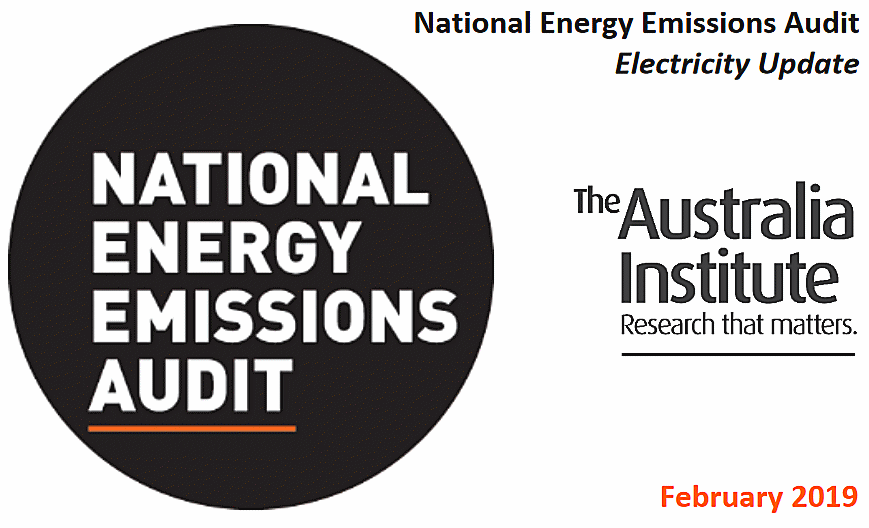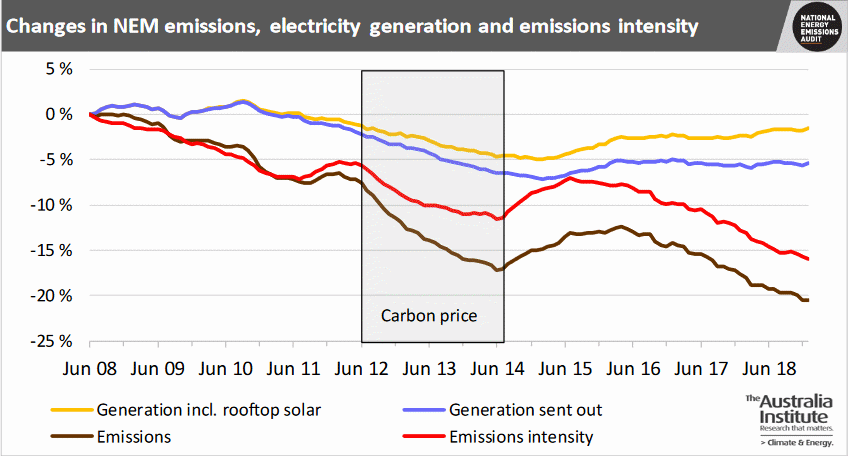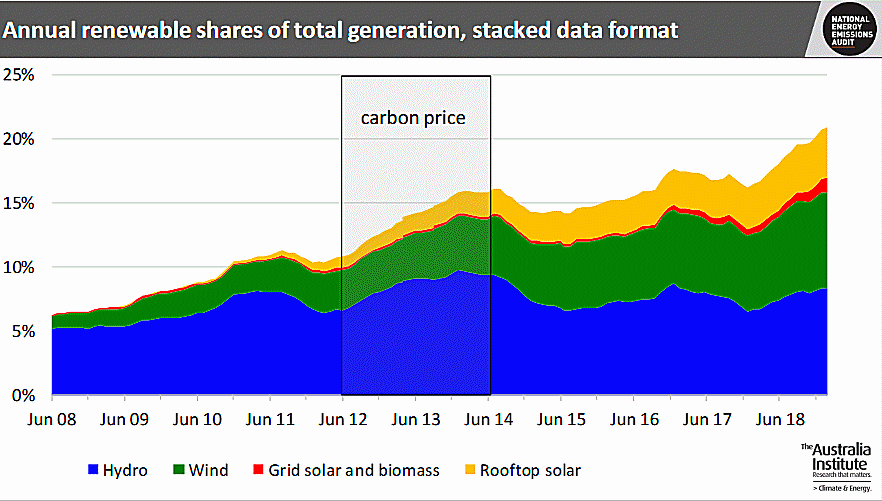
The Australia Institute’s (TAI’s) latest National Energy Emissions Audit for the electricity sector covering January 2019 has been released. There’s good news – thanks to renewables.
Authored by Dr. Hugh Saddler, the NEEA Electricity Updates provide data on electricity demand, supply and generation emissions in Australia’s National Electricity Market (NEM), plus demand in WA’s South West Interconnected System (SWIS).
Just to clarify – the NEM consists of Queensland, New South Wales, ACT, Victoria, Tasmania and South Australia. The fact it’s called “national”, but doesn’t include WA or the Northern Territory has been a source of never-ending irritation for SQ’s Ronald.
Anyhow, among the key findings in TAI’s latest report is that while there was increased demand in January and consequently emissions also increased slightly, emissions intensity continued to decrease due to the influx of renewable capacity.
Other findings include:
- Wind and grid scale solar power are supplying a bigger share of annual grid generation than hydro power, and this is set to continue
- South Australia is now firmly above 50% renewable electricity – SA first bypassed that figure in August last year.
- The growth of renewable energy and fall in coal-fired power generation has resulted in more than a 20% reduction in annual emissions in the NEM compared to its highest level in the year to September 2008.
The report notes when estimated rooftop solar is included, renewables generation reached 21.0% of all generation in the NEM in January, and all non-hydro renewables reached 12.6%.
Coal Fails, Solar Saves
Also covered in the report was the impact of January’s heatwaves, when coal failed while solar power soldiered on. It was the absence of approximately 1,300 MW of brown coal generation through plant failures and rather poorly-timed maintenance that resulted in some load shedding in Victoria. And things could have been a lot worse.
“If we take one lesson from the record breaking heatwaves this summer, it is that solar saved the day,” said Dr. Saddler
Dr. Saddler also commented that the growth of solar power and wind energy within the NEM will do far more to reduce emissions than the Morrison Government’s Climate Solutions Fund.
The full TAI report can be downloaded here.
TAI hasn’t been a huge fan of Morrison Government policies relating to energy and climate change. Recently it said that based on legal advice TAI had received, Federal Energy Minister Angus Taylor lacks constitutional authority over electricity and authority to fund projects under the Morrison Government’s Underwriting New Generation Investment Program. That program has attracted coal project interest.



 RSS - Posts
RSS - Posts



My understanding is that the “Climate Solutions Fund” is being used to fund coal mining replacement of oil/gas generators to diesel generators.
This will leave the mining companies in a much better position, because the Australian government subsidises the cost of Diesel in Australia.
Effectively, we’ll pay for Miners upgrades, then pay for their ongoing operating costs, while doing very little to reduce pollution and carbon.
Daniel Debreceny,
You state:
“My understanding is that the “Climate Solutions Fund” is being used to fund coal mining replacement of oil/gas generators to diesel generators.”
IMO, switching to diesel generators is not a long-term sustainable solution. There are some indications that global peak diesel supply occurred in 2015.
See: https://cassandralegacy.blogspot.com/2018/12/peak-diesel-or-no-peak-diesel-debate.html
The referred blog post includes these concerning statements:
“Shale oil has changed a lot of things in the oil industry, but it couldn’t avoid the decline of conventional oil. That, in turn, had consequences: shale oil is light oil, not easily converted to the kind of fuel (diesel) which is the most important transportation fuel, nowadays. That seems to have forced the oil industry into converting more and more “heavy” oil into diesel fuel but, even so, diesel fuel is becoming gradually more scarce and more expensive, to the point that its production may have peaked in 2015. In addition, it has created a dearth of heavy oil, the fuel of choice for marine transportation. In short, the famed “peak oil” is arriving not all together, but piecemeal — affecting some kinds of fuels faster than others.”
IMO, by the time global peak diesel supply is actually confirmed it will be too late to find and deploy alternatives – we’ll already be in an energy constrained crisis. Alternatives to petroleum-based diesel fuels need to be deployed at large scale now if we are to avoid transport energy shortages.
Humanity must leave petroleum oil before oil leaves us. That’s an enormous (probably unprecedented) challenge.
I don’t think I’d seen that chart before, but the other impressive thing it highlights is just how effective the carbon price actually was, and just how much of a stuff-up Tony was. Imagine where we’d be now with an effective carbon price AND the massive price improvements in solar deployment!